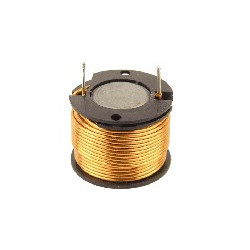
One example would be that iron core coils have a low stray magnetic field, which can help solve various issues. Yes, there is a range of advantages to using iron core coils. Do iron core coils offer advantages compared to other inductors? Therefore, an iron core coil is the cheaper alternative to an air core coil. To conduct the same work, an air core is less efficient, generates more heat, and necessitates thicker wire and more turns. As the magnetic field decays, the iron also aids in the dissipation of heat generated by current travelling through it. When a capacitor is added to the circuit, it generates a "tuned" circuit that works similarly to a pendulum. The inductance of an iron core varies based on the positioning and area of the iron in the core. Here at SoundImports, one can choose, compare and buy iron core coils from well-known brands such as Dayton Audio, Jantzen Audio and Mundorf. However, iron core coils are only recommended for bass and mid-sections on crossovers. These coils provide a robust and cost-effective alternative to air core coils by maintaining the same amount of magnetic flux by using a much smaller size. Also, iron core coils have a considerable size advantage due to their very high magnetic permeability. Things are not that exact with this.An iron core coil is made of laminated iron connecting the winding, as the name suggests. If forms that fit the model are not available, you can interpolate by the forms that are larger or smaller. If possible, try to keep the DC resistance below 1 ohm, even 1/2 ohm if possible. The 18 gauge wire has about a third of the cross-sectional area of the 14 gauge, and shoud cost commensurately less-but have higher DC resistance. Suffice it to say, American gauge 14 thru 18 are the best choices. I would post the chart, but it dies not fit with the posting parameters of this BB program. I believe the chart is in American gauge wire. Note that the wire diameter, in Metric, is included so you can get the right gauge. Note: I believe the wire gauges are somewhat different in America and India. Using that program, here are wire guages, forms, etc. If you are using an 8 ohm speaker and a 12dB/octave crossover, you want the inductor to be about 12 ohms at the crossover frequency. The men in the white coats should be coming for me any moment now. Yesterday I posted a long message telling you I was going to to give you the link to an air core inductor calculator. Let us know how you are making out on the project!

You would have to knowĪ) the permeability of the ferrite you are working withī) the inductance of a given ferrite inductor and just calculate how many more turns are required to change it.

Other forms of ferrite require more turns of wire-less than air core inductors, of course-but give low distortion that begins to approach air core inductors. Some ferrite cores add a lot of distortion but gives you a lot of inductance for a comparatively few turns. However, there is one thing-there are different kinds of ferrite. I might be able to dig up something for a ferrite core inductor. If you plan on crossing over at 500 Hz or above, then air core inductors are a reasonable way to go.


Say dhar, just how big an inductor do you need? Alternatively, where are you trying to cross over? If you are looking to crossover at 100 Hz, then air core inductors might be simply too big. Fill in the desired value in a box-bing!-get the number of turns you need. If you have decided to go air core, this is one more program to help you. I am sure the CAL SOD program is good, but this is one more option. Well, it's a little late, but I could not help but post this real easy air core inductor calculation program I came across.


 0 kommentar(er)
0 kommentar(er)
